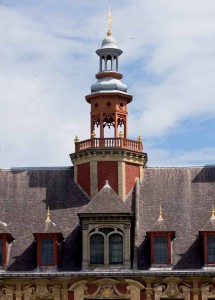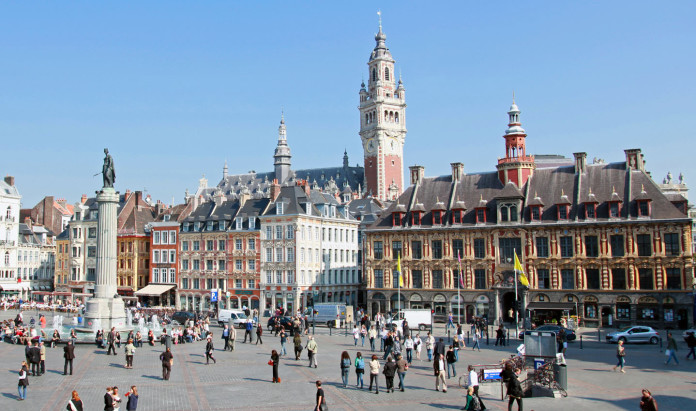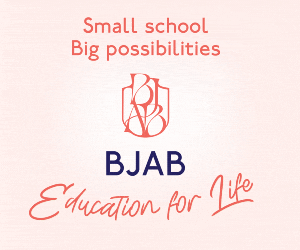Situated in northern France near the border with Belgium, Lille is at the crossroads of Europe’s high speed rail network. Colin Moors recommends getting off the train and spending some time there
A jewel in the midst of old Flanders, Lille – or Rijsel in Flemish – is a town that has gone from being down-at-heel with a dying cloth industry to a must-see attraction for shoppers, diners and day trippers. Lille is so close to Brussels you could reasonably go there for lunch, but there is a whole lot more to this town than the food.
Since the arrival of the Eurostar terminal in 1994, and the subsequent revival of the town’s economic fortunes, Lille has proven to be the very model of how best to invest a massive amount of cash. Getting there from Brussels couldn’t be easier – an hour or so by car, or a gentle half hour by Thalys.
“THEY ACTUALLY WANT PEOPLE TO COME AND ENJOY THEIR TOWN”
French, of course, is widely spoken but the locals will also converse in Ch’ti, a form of Picard spoken in Northern France. Why not download an app for your smartphone and learn some – it exists, really. Alternatively, they will happily chat in Flemish – the languages make no difference to a town that’s full of friendly people. There’s certainly a warm welcome in most establishments; it’s almost as if they actually want people to come and enjoy their town.
GENERAL DE GAULLE

The first place most people will probably want to visit is the Grand Place. Also known as Place du Général de Gaulle and named after one of Lille’s more famous modern-day sons, the square is a delightful if somewhat odd mix of French and Flemish classical architecture that really embodies the flavour of Lille itself – a hybrid town and happy to be so. The highlight of the Grand Place is the beautiful Vieille Bourse, a Flemish Baroque construction forming a square with a courtyard and ornately decorated with plaques, carvings and some rather mischievous looking gargoyles. Although it may look as if it was purpose-built, the square is actually many houses all joined together – they knew how to do a house conversion in those days.
CITADEL
A little further out of town, around one kilometre or so, is the old citadel. After Lille had been reclaimed by the French in 1688, the citadel was built and the city walls strengthened to resist the advances of any other country that fancied invading and claiming it for their own, an unfortunate hazard of being Lillois in those days. The citadel was built to resemble a five-pointed star and was double-walled and moated to ensure nobody could just walk in uninvited. The designer, Sébastien le Prestre de Vauban, designer of over 150 fortified buildings, called it “queen of the citadels”. He may well have kicked himself when it was overrun by forces loyal to Spain, Holland, England and Portugal just 24 years later.
These days, happily, the citadel can be sauntered into without fear of cannon fire. Home to the French Rapid Reaction Force, it’s quite a sedate ramble around the two km perimeter – just watch out for the armies of joggers and roller-bladers. For children, and indeed the whole family, there is a zoo just outside with many species of birds, apes and other assorted fauna. There’s even a pair of rhinos. Best of all, admission is free, and it’s open from March through December.
FOOD AND DRINK
“LILLE I S VERY MUCH THE PLACE TO GO FOR LUNCH”
All this jaunting around will doubtless leave you feeling hungry. Before the restaurant recommendations, two points to bear in mind. Firstly, the people are lovely but appear to be in no tearing hurry – it’s probably best to fit in with their timetable and not rush. Secondly, the Flemish influence converges somewhat with the French, so you’ll get good quality French food and Flemish portions. The two watchwords here are ‘delicious’ and ‘huge’. For a languorous lunch, try Au Paon d’Or (2 Place de Béthune, 59000 Lille T.+33(0)3 20 42 83 52). It’s just off the tourist trail, but not by much, and the vispotje, moules or even ham and frites are really tasty. Again, service is pleasant, but slow.
For something extremely Lillois, try La Guinguette de la Marine (8 Ave Léon Jouhaux, 59000 Lille T.+33(0)3 20 39 85 43), a family-run place you simply have to book to eat in. The place is dripping with authenticity, from the swings at the bar (yes, swings) to the cheesy soundtrack, matched only by the cheesiness of the menu. Try the Flamische de Maroilles, a quiche-like affair made with the local cheese, or the ‘Welsch’, a dish made with bread, ham and cheese – lots and lots of cheese. Not recommended for low fat diets, but divine. Both are served with more frites than you can shake a salt cellar at and washed down with an artisanal beer.
Speaking of beer, Lille may well have the highest number of beers and bars per capita outside our own dear Brussels. If you can’t find a place to get a drink in Lille, you really aren’t trying. Probably the best bet is to give Les 3 Brasseurs (18 Place Gare, 59000 Lille T.+33(0)3 20 06 37 27). Savour one (or many) of their beers, or take a chance on La Mousse du Moment, the latest experimental beer being brewed. They are all brewed on the premises and taste fresh and lively. Best value is the tasting palette, offering the four main beers in 12cl glasses. In reality, these glasses tend to be filled to around 16cl, so you get a lot of beer for your money. The gluttonous could go for the metre of beer (10 x 25cl) or share it with friends if they insist.
Lille is very much the place to go for lunch – but don’t be surprised if you end up staying the whole day, and go back for more.







